Antwerp Pride celebrated its fifteenth anniversary in 2022. For this special edition, they looked into the future and searched for Queertopia: what will the ideal LGBTQIA+ world look like in 15 years from now?
UAntwerp contributed to this brainstorm. As part of the 2022 Antwerp Pride theme, we are proposing five lines of scientific research that center queerness.
How can you be gay in French literature? - Maxim Delodder
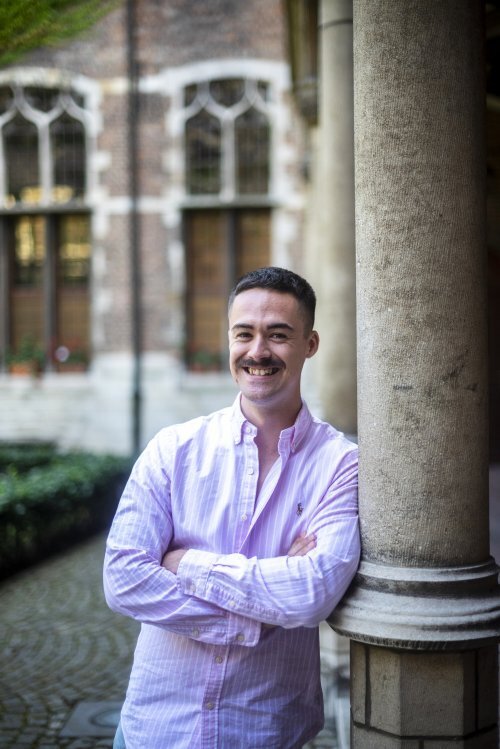
Maxim Delodder (Language and Literary Studies) looks at 'being gay' in contemporary French literature. "Proust is a doomsayer. He thinks that gay men fall in love with 'real men', who in turn fall in love with women".
His master's thesis focused on masculinity in French literature, but Maxim Delodder realised afterwards that he actually wanted to discuss homosexuality. He is studying contemporary French authors for his doctoral thesis. Their main characters are gay and written in first person, but they differ in the way they present their complex identity and experience their sexuality.
First Person
Delodder consciously selects books written in the first person because it is "a very direct way for the author to write from his own identity". As a researcher, Delodder questions how homosexuality is expressed, but also "what the author does not say and hides".
He sees a clear dichotomy within his research. "In the 1990s, AIDS is very much present in the literature because it was a much more active epidemic then. From 2010 until now, homosexuality is described in a way I can recognise myself in. Of course, I know how the world has evolved since then, so I also read those books from the 90s with the eyes of someone from the PrEP era (Pre Exposure Prophylaxis, or HIV-inhibiting pills, ed.).
"When I read books about AIDS, I read them through the eyes of someone from the PrEP era."
The sailor
The central figure and common thread in his research is 'the sailor' - a tough, powerful, positive, free-spirited figure - think Jean Paul Gaultier's perfume bottles or the Village People's song 'In the Navy'. "The sailor is a stereotypical gay man who has been appearing in literature since the beginning of the 20th century," says Delodder. In addition to the sailor, he has also researched texts from Muslim and Jewish communities for references to homosexuality. "So far, my work has been pretty tame. In my final year, I want to look at how sex is described, because apps like Grindr, for example, also have an impact on literature."
One book he would recommend is Jean Genet's 'Querelle de Brest' (1947). "Every time I read it, I change my mind about what the book is about. Querelle is never really labelled, and that's what I love about it. Genet's language is a very civilised French combined with the French language of the street in the 1940s, which works very well. Antwerp is also in the book. Querelle steals gold and jewels everywhere and is said to have a hideout in the cathedral tower.
Pride
Delodder gives no clear answer when asked whether it is a good thing that queer literature is marketed as such. "As a reader, I like the fact that books about homosexuality are among other books, but as a researcher, I think: 'Put a rainbow flag on it and just emphasise the uniqueness of the book'. Yes, I like pride. I like the idea of showing what you stand for. For example, Marcel Proust's work creates the idea that gay men are doomed because they fall for 'real men' who fall for women. But when I look at myself and the people around me, that is not true. Someone who is open about who they are has a pride. And that in itself is very attractive".
How does a Queer Utopia affect family law? - Frederik Swennen
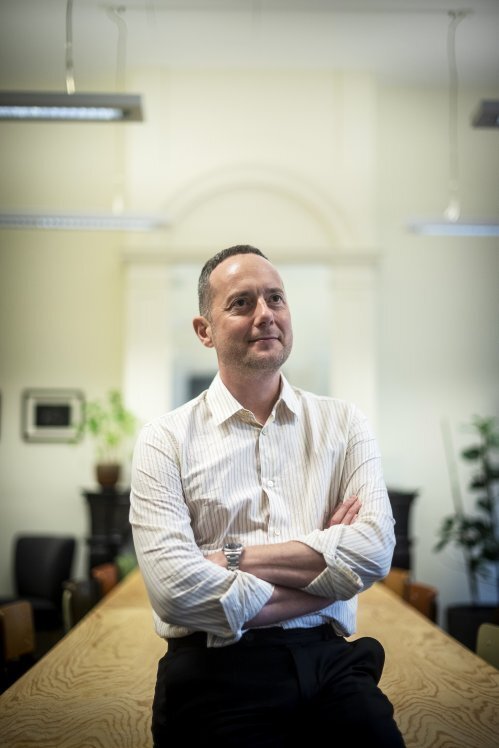
Dean of the Faculty of Law, Frederik Swennen, explores how family law changes when we dare to question the foundations of relationships and parenthood. "Why don't we acknowledge relationships with more than two people?
"There are two main institutions on which all family law is based: couple formation and parenthood," Professor Swennen explains. The government took steps to open both institutions to same-sex couples from 1999, when the Christian Democrats were out of power and we had a purple coalition. Gay couples have been allowed to marry since 2003, to adopt children since 2006, and since 2014, co-motherhood has been introduced: the partner of a woman who gives birth to a child using donor sperm automatically becomes a co-mother.
What's in a name?
But these changes fall well short of what is needed because in today's law having a relationship refers to two people having a sexual relationship and/or living together. "This model is completely outdated," says Swennen. "Why not recognise relationships that involve more than two people, polyamorous relationships, non-sexual relationships, living together with friends or LAT relationships?"
What would happen to this law? You would be able to marry more than one person, inheritance law would change, it would be easier to buy a house with three friends, and you could get tax breaks, leave of absence or carer's leave in respect to people other than your one romantic partner. Swennen's solution is a modular system where you can choose which layers you want.
Parenting
The concept of parenthood also needs to be challenged, says Swennen. We are still stuck with the idea that a child has two parents who are, or have been, in a relationship, even though much more is now possible through medically assisted reproduction. "For example, you can only do a two-parent adoption if you are a couple, not a three-parent adoption, and certainly not if you are not a couple.
This has since been challenged. There was a constitutional court ruling in Belgium a few years ago. Two twin sisters were both single and living together. One of them had a desire to have children and became pregnant using the sperm of an anonymous donor. When the other twin sister also wanted to adopt the child, they were at odds with the limits of family law because the women were not a couple. However, the Constitutional Court ruled that this was discrimination. As a result, the child officially had the twin sisters as mothers.
Is family law currently in a state of upheaval? Swennen says we still have a long way to go. "There have been no developments in legislature since the ruling on those twin sisters. The classic argument is that it's too complicated for the children," says Swennen, "but romantic couples who have children together don't always plan it, platonic parents often have."
What about the idea that a child needs two caregivers? "Grandparents have also played an important role in raising children at various times in history, such as during wars," Swennen says. So, the traditional family of a father, mother and children is certainly not the only valid option, he believes.
Legal template
Meanwhile, Swennen says, lawmakers are confronted with adoption waiting lists for gay couples and whether surrogacy should be allowed. "But," he says, "we would do better to question the fundamentals, because if a gay couple can have a child with a girlfriend or with a surrogate, and there is a legal template for that, as with classical parenthood, then this problem will solve itself."
Swennen sees this as an opportunity for lawmakers to draw the line before it is too late. "Right now, people are preoccupied by the details. The legislature makes the rules, but if you close one hole, the water is going to run out in ten other holes."
What advice does Swennen have for people who want to have a child in an unorthodox manner? "Discuss things very carefully and have them legally recorded by a lawyer or notary if necessary. But not too rigidly, because in life, relationships and parenthood tend to fluctuate."
What about gender and sexual diversity in children's media? - Thalia Van Wichelen
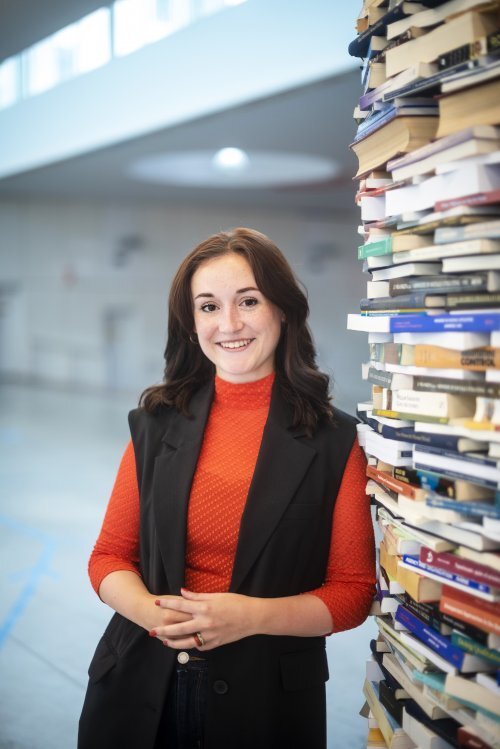
Thalia Van Wichelen (Communication Studies) is researching how gender and sexual diversity is best represented in Flemish children's media. "Gay characters used to be portrayed in a very stereotypical way, now they are just very normative," she says.
"Back in the day, in terms of representation, you had Alberto in Samson & Gert and Steve in W817," says Thalia Van Wichelen, who is writing her doctoral thesis on gender and sexual diversity in Flemish children's media. "Today you have much more representation in mainstream media and this is gradually seeping into children's media."
Fewer resources, less diversity
Van Wichelen's research is threefold. In recent years, she has investigated which examples of gender and sexual diversity are found in Flemish children's media, but also how they are represented. For the second part, Van Wichelen spoke to several directors and also to Annemie Gulickx, Ketnet's network manager. "VRT has a policy of diversity both in front of the camera and behind the scenes. Ketnet is trying to represent that diversity really well, through child psychology, child panels and people from the LGBTQ community. It's different for commercial channels, they have to deal with fewer resources and you can see it in the result.
A singing hairdresser
Does Van Wichelen have a good feeling about the state of representation today? "In terms of quantity, there has definitely been an increase in diversity. There used to be fewer characters, and they were portrayed very stereotypically: Alberto, for example, a hairdresser with feminine features who sings opera. Today, the portrayal of gay men is just very normative, with the idea that they are also masculine men. In Ghost Rocket, for example, there is a guy who is very athletic and very masculine. The girls are trying to hit on him, but the plot twist is that he actually likes boys. I think showing diversity within diversity, not just one or the other, is the challenge for children's media.
Not all parents consider it 'appropriate' to expose children to non-heteronormative partnerships. This is why Van Wichelen is talking to the general public for the third part of her research. "Many parents think they are progressive, but if you keep interrogating them, you often come up against a brick wall," she said. A non-binary character, or a trans persona such as in 4eVeR, could face more resistance than, say, a gay couple. The same is the case with displays of affection. Kids themselves, on the other hand, are fine with different forms of gender and sexual diversity, as long as it is presented to them in a way that they can understand.
How are transgender experiences represented in Dutch prose? - Sven Van den Bossche
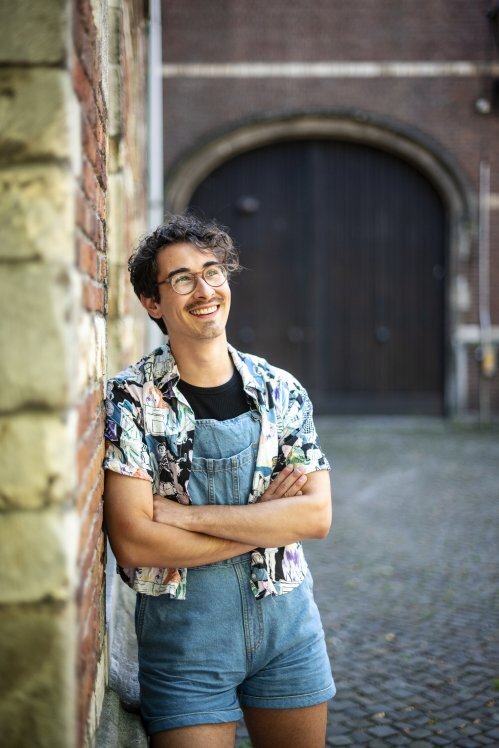
Sven Van den Bossche (Language and Literature) examines narrative strategies used in Dutch fiction about transgender experiences. "Convincing stories from gender clinics don't suffice. Everyone has doubts".
In his research project 'Born in the wrong story', Sven Van den Bossche examines the way in which transgender experiences are described in Dutch narrative prose from the year 1960 up to the present day. The starting point is no coincidence. This is the moment when the first gender clinics were established in the Netherlands. To this day, these are important institutions that have had an impact on the way trans people talk about themselves and the way others talk about them. According to Van den Bossche, however, gender clinic stories are not enough: "People tell a psychologist their life story in a way convincing enough to qualify for transition," he says. "They supposedly all feel like the opposite sex from the beginning and 100%, which is again very binary." Everyone has doubts, "because it is part of being human," says Van den Bossche. He would like to look for the complexity in literature, "because there are far more possibilities."
Animal metaphors
A novel like Marieke Lucas Rijneveld's "Mijn lieve gunsteling", for example, uses animal metaphors to speak about a trans experience. "The gender of the animals is less relevant, and as a result, the reader is liberated from these ingrained categories," he says. In the book, we also have to deal with a narrator who is unreliable, who even has a sick mind. And yet this narrator is also the one who makes all sorts of things possible. "The narrator creates a strange, non-normative worldview, which also allows us, as readers, to look at gender in a different way", says Van den Bossche.
Natural process
For his part, Van den Bossche believes that "Het Jongensuur" by Andreas Burnier is a book that should be read in every secondary school. The special thing about this novella about a child who has to go into hiding during the Second World War is the development of the story - because each of the following chapters of the book goes back in time by one year. According to Van den Bossche, the trans experience in "Worm Moon" by Marikan Heitman is also special. "Gender is described there as a very natural and symbiotic process that is connected to the people around you. It is shaped by the culture and customs of the environment, and it can also be changed." Van den Bossche's research will continue for another two years.
How is masculinity reflected on in Antwerp fashion? - Nicola Brajato
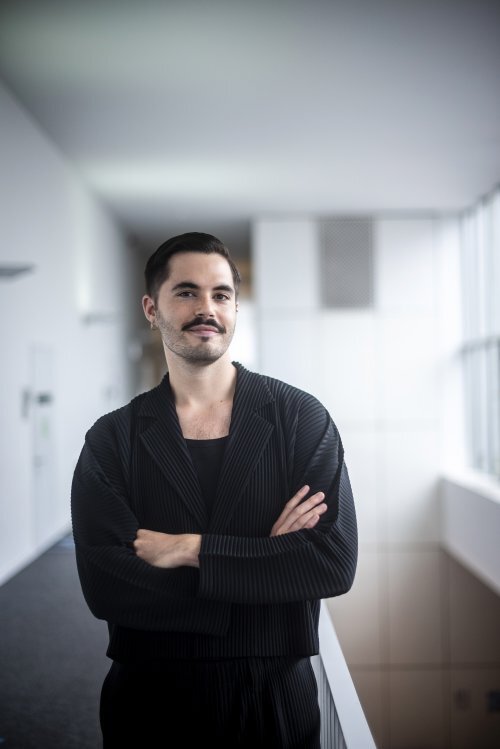
Nicola Brajato (Communication Studies) examines how graduates of the Antwerp Fashion Academy question masculinity in their creative process. "Fashion is an excellent field of research to detect social change," she says.
"Let's not underestimate fashion," begins Nicola Brajato. "Fashion is deeply linked to our identity. It's part of everyone's life. Through the way you dress, you make choices about how people perceive you." He studied how designers reflect on masculinity, sexuality and the male body after graduating from the Antwerp Fashion Academy - a school still internationally renowned as a place for conceptual, experimental and avant-garde fashion. Brajato also works closely with MoMu for his research and has access to their archives. "Fashion is an excellent field of research to detect social change," he says.
The do-it-yourself era
His research goes back to the 1980s, when Belgian fashion was supported by the government with subsidies and competitions, and the 'Fashion, this is Belgian' campaign was launched. Before that, the focus had been on Paris, but from the 1980s, with new people at the helm of the academy, fashion in Antwerp took on a more individualistic slant. In 1986, the Antwerp Six began to exhibit in London, and later in Paris. "It was a time when economic, political and cultural institutions created a very specific network for designers," says Brajato. Retail was gaining relevance, but Antwerp designers opted for small, experimental editions. They did not have big budgets to advertise in fashion magazines; these were DIY times. "Antwerp became a place of resistance to the norm, also in terms of gender, body and sexuality," says Brajato. The mainstream idea of masculinity was dismissed, challenged and mocked by the designers of that time. "Walter Van Beirendonck created very strong, extroverted looks, like a middle finger to the ideals of the bourgeoisie. But there was also Dirk Bikkembergs, who eroticised the male body with archetypes like the athlete and the adventurer. Both designers clearly showed that masculinity is a plural concept.
Tailoring
Brajato finds the practice of 'tailoring' particularly interesting to research, as a tailored suit is seen as the quintessential, normative masculine look. "Walter Van Beirendonck challenged that practice and made it his queer interpretation," he says. The way in which the male body has been and is represented in fashion campaigns is also the subject of Brajato's research. He calls Raf Simons a game changer. "Contrary to what was prevalent in his time, Simons highlighted the slender male body," he says.
Designers such as Demna Gvasalia, Bernhard Willhelm or Glenn Martens also reflect gender in fashion in interesting ways, says Brajato, because they deliberately make less of a distinction between women's and men's fashion, but rather look for a way to create gender-fluid fashion, cuts where cross-pollination occurs. "They don't design clear lines in one direction, but lines that intersect along the way," says Brajato. He also talks about how the younger Lisi Herrebrugh and Rushemy Botter, the people behind the 'Botter' brand, are deconstructing and rebuilding the concept of tailoring. "Their work is based on black cultural identity, but also on environmental issues. It shows that the Antwerp Academy is still producing real talent with an interesting vision of fashion.